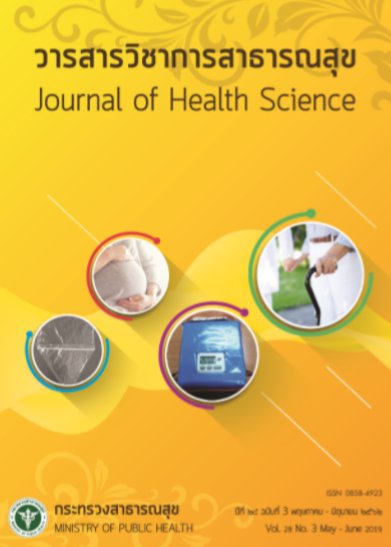Effects of Care Protocols after Transfemoral Coronary Angiography, Cardiac Catheterization Laboratory Unit, Lampang Hospital
Keywords:
coronaryangiography, vascular complication, post coronary angiography care, satisfactionAbstract
The aim of the study was to evaluate the nursing care protocol after transfemoral coronary angiography on vascular complication, back pain, and the patient satisfaction level. This study was prospective, randomized, parallel group, double blinded controlled trial. Two hundred and seventy two patients with elective coronary angiography transfemoral approach and manual compression at Lampang hospital during February 2016 to December 2017. The patients were assigned into two groups, the control group (N=134) and the experimental group (N=138) by 1:1 randomized allocation. The patients in both groups were applied with sand bag at femoral access site for two hours and ambulated after 4 hours of sheath removal. The tool used in the experimental group was the nursing care protocol, which was developed and validated with validity index evaluation by three experts (validity index 0.92). The patients in experimental group were subjected to position change by elevating the head from 15 degree to 45 degrees in four hours after removal sheath. The patients in control group received routine care protocol, which was in supine position and head elevation 15 degree without changing for 4 hours. The results of the study revealed no statistical significant difference between experimental and control group in 24-hour access site hematoma (5.80% VS 8.20%, p=0.435) and puncture site bleeding (1.40% VS 4.50%, p=0.168). The patients back pain score at 4 and 6 hours in experimental group were lower than the patients in control group (1.78 VS 2.28, p<0.001 and 0.46 VS 1.16, p<0.001, respectively). The patient satisfaction level score was higher in experimental group then control group in all modalities of evaluation (p<0.001). In conclusion, the used of nursing care protocol after transfemoral coronary angiography did not increase the risk of vascular complications. The changing in patients position is the non-invasive, non pharmacologic and powerful nursing tasks to relieved the patient’s pain after removal femoral sheath from transfemoral coronary angiography. Proper nursing planning may be helpful to reduce the risk of vascular complication, reduce prolonged bed rest and increased the patient’s satisfy. The nursing care protocol should be applied and advantageous for the patient’s with low risk of vascular complications.
Downloads
Downloads
Published
How to Cite
Issue
Section
License
Copyright (c) 2019 Journal of Health Science - วารสารวิชาการสาธารณสุข

This work is licensed under a Creative Commons Attribution-NonCommercial-NoDerivatives 4.0 International License.







